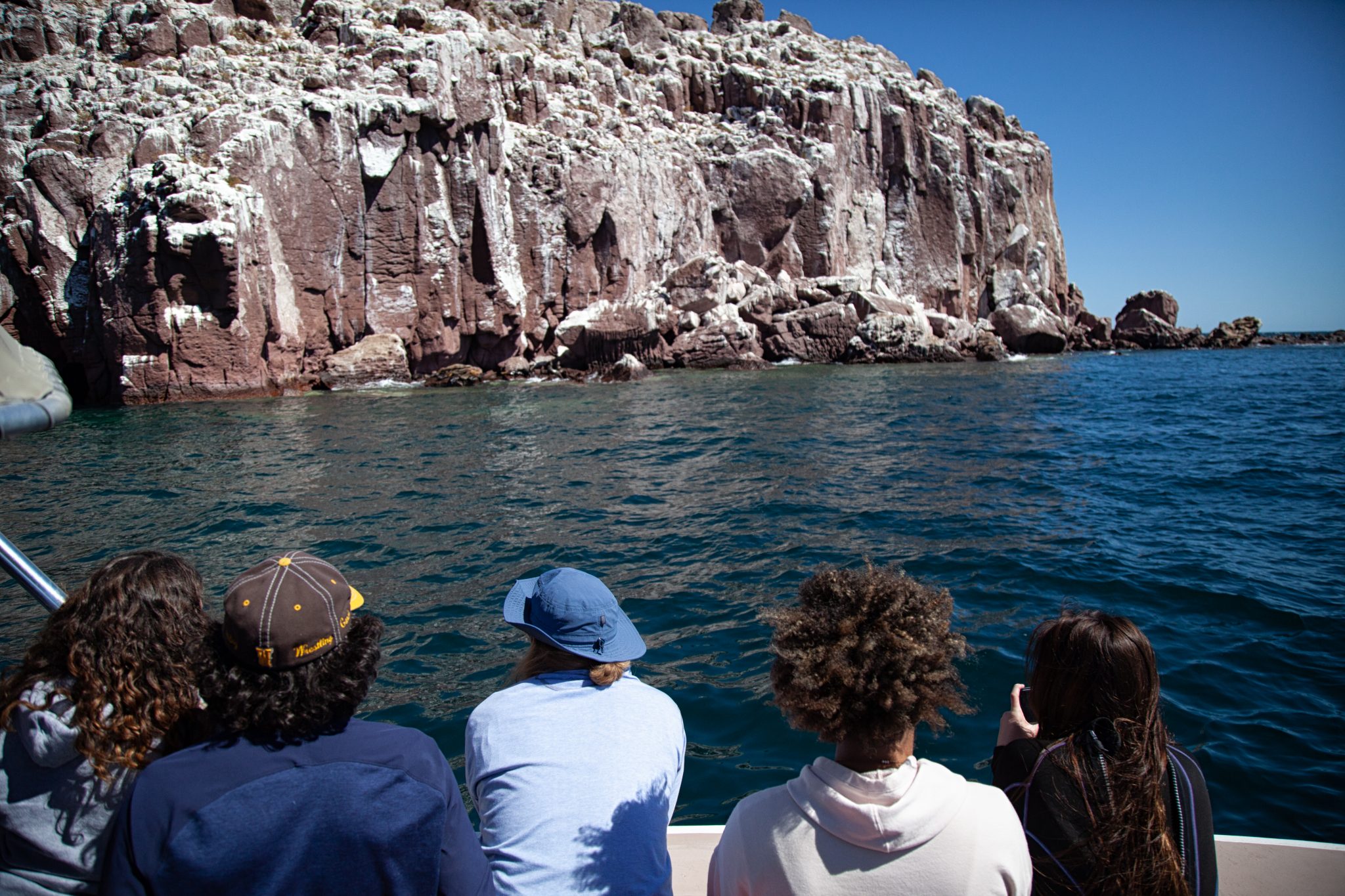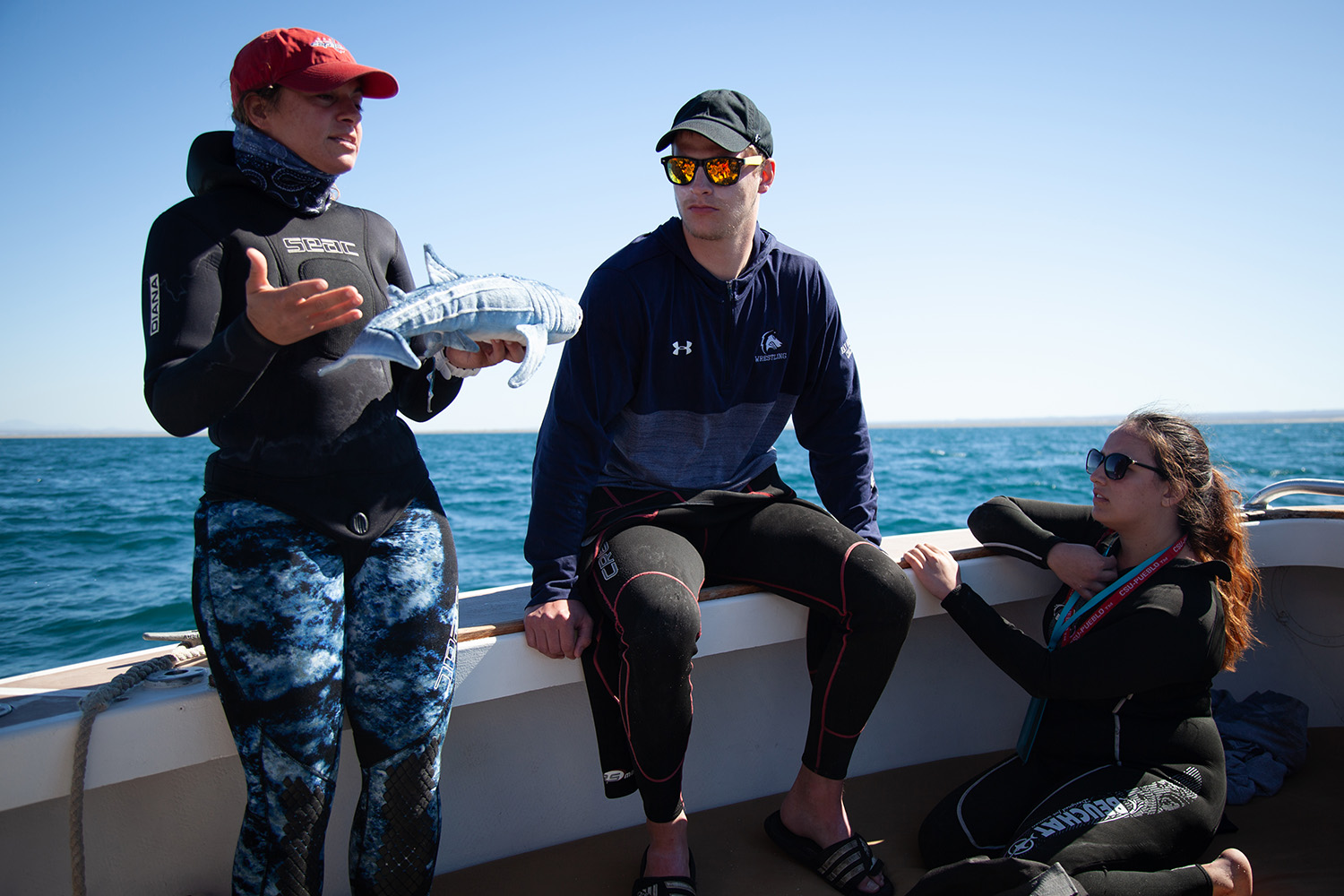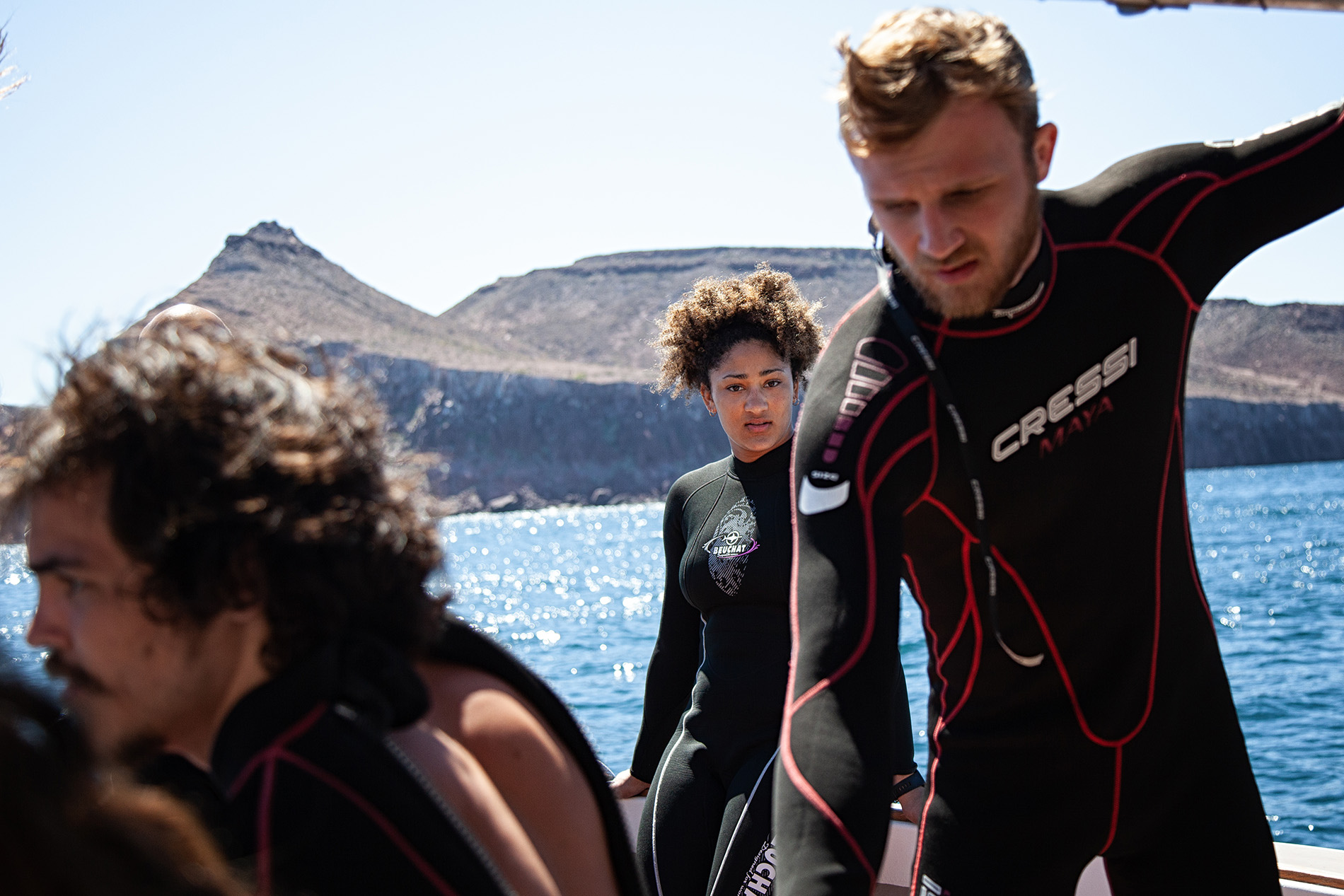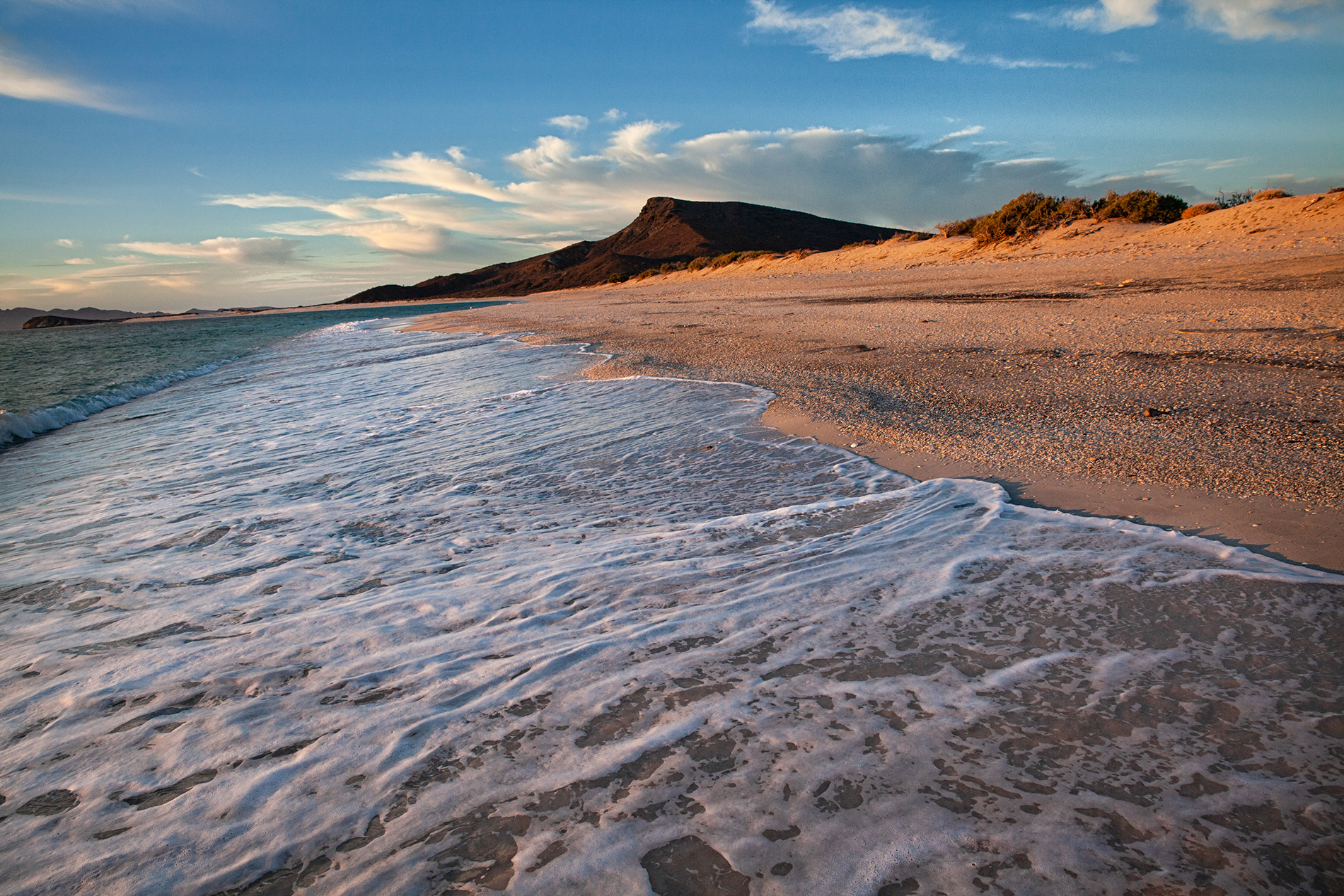Photo by Carlos Aguilera
By Coleman Cornelius
Aboard a boat called “Hot Pursuit,” 11 undergraduates and a professor were bound for a snorkeling destination in the Gulf of California, the sea that separates Baja California Peninsula from mainland Mexico. Jacques Cousteau, the late ocean explorer and father of scuba diving, famously called this sea “the aquarium of the world” for its dazzling diversity of underwater species. As the students from Colorado State University-Pueblo boated across the gulf in March, their faces sprayed with briny water each time the vessel hit a swell, they had an inkling of what was to come.
For weeks before their launch from La Paz, the capital of Baja California Sur, the students from Pueblo had considered the gulf, and the ecological and human complexities moored to it, as a case study in ecotourism. Yet reading about these tangled topics – environment, culture, economy – is nothing compared to experiencing their interplay. The students were here, using CSU Todos Santos Center as their basecamp, to immerse themselves in the branch of tourism that highlights sustainability, with the goal of protecting natural resources and their multilayered values.
Photo by Carlos Aguilera
Ecotourism appealed to these students as part of their major studies in biology and recreation. They had learned about the field’s relevance to Colorado, which presents mounting challenges in balancing public access to nature with protection of wild places that attract throngs of visitors. In April, for instance, Glenwood Springs started a new reservation system to reduce hiker impacts at iconic Hanging Lake; meantime, Rocky Mountain National Park, which tallied a record 4.6 million visitors in 2018, has enacted progressively tighter restrictions on private vehicles in an effort to manage crowds.
Daniel Bowan, an assistant professor of recreation management and outdoor leadership at CSU-Pueblo, led the trip to Mexico and hoped a close-up view of conservation issues in an entirely different setting would help his students understand challenges at home. “We talk a lot about different uses of areas and what’s appropriate for those settings,” Bowan said, adding, “The more you see other ecosystems, the more your own makes sense to you.”
Yet, as Bowan knew from earlier expeditions, the Pueblo students would also benefit immeasurably from the adventure, self-discovery, and cultural exchange afforded by the weeklong trip to Mexico. These were among the key reasons for building the CSU Todos Santos Center, which is marking its fifth year of academic programming in a village on the peninsula’s southern Pacific Coast. They are also primary reasons Timothy Mottet, president of CSU-Pueblo, hopes all students on his campus will eventually have the chance to visit and learn here.

“The Todos Santos Center shows students that the world is our classroom,” said Bowan, who has led several courses in and around the center. “The highest form of learning is what we experience. Now these students will have this transformational experience that they’ll always draw from. They’ll be able to ask, ‘How does this transfer to other parts of my life? How do I carry it with me?’”
“Everyone will take something different from today,” he predicted.
As the students from Pueblo boated in morning sunlight, they soaked in their surroundings on the gulf, also known as the Sea of Cortez. They passed tiny islands, with crests covered in Mexican giant cactus, spiked arms reaching skyward as if in praise, and rugged volcanic flanks falling abruptly to crystalline waters. A pair of brown pelicans glided in formation over choppy waves. In the distance, a Munk’s devil ray breached the water’s surface and briefly outstretched its wing-like fins before splashdown.
“It’s not like anything I’ve ever seen,” said Kiara Olson, from Colorado Springs, a senior in biochemistry who wants to pursue veterinary medicine. “It’s absolutely astounding how much life is in the Sea of Cortez.”

Soon, the boat slowed as it approached a highlight of Archipelago de Espiritu Santo, a protected national park encompassing a series of islands, inlets, and stunning beaches. Ahead were Los Islotes, islets of purplish rock that anchor a year-round habitat for California sea lions. A permanent colony of some 300 sea lions resides at Los Islotes, which form a nursery protecting the animals from predatory orcas and sharks. It’s also one of just two places worldwide, along with the Galapagos Islands, where visitors may swim with these playful underwater acrobats under controlled conditions. As if on cue, two sea lions popped up, their heads bobbing above water as the “Hot Pursuit” docked to buoys demarking a snorkeling zone. On the rookery, adult and juvenile sea lions luxuriated in the sun amid a chorus of barks, squeals, and yawps.
The students zipped their rented wetsuits, and gathered snorkels, masks, and fins as their tour guide, Mauricio Duran, provided instructions. Life vests were required, Duran explained, not so much for the safety of the swimmers, but to prevent diving and disruption of the sea floor. For the same reason, the number of boats allowed at Los Islotes was tightly regulated by the Mexican government; those allowed could not anchor, but tied to buoys. Duran sent each student into the 70-degree water with an enthusiastic, “Yi-hoo!” An hour later, they clambered back into the boat, breathless and grinning.
“It was pretty much the coolest thing I’ve ever done in my life. It’s like I was at home playing with my dog,” said A.J. Cross, excitedly describing the mix of fear and delight he felt while face to face with a sea lion. Cross, who grew up in Fountain, south of Colorado Springs, hopes to work in a public park and had never been in an open-water setting beyond Lake Pueblo. “This is definitely a life experience I never thought I’d have,” he said. “The fact we can conserve this and still experience it is what it’s all about.”
Next, the group cruised to a secluded cove for a midday break. “OK, guys, before we get out of the boat, remember this is a national park,” Duran told the students, while looking across sparkling water to a breathtaking beach on Isla Espiritu Santo. “‘Take nothing but memories, leave nothing but footprints.’” He recited an international mantra for naturalists, attributed to Chief Si’ahl (anglicized as Chief Seattle), a leader of Native American tribes in the Pacific Northwest in the 1800s. The Archipelago de Espiritu Santo is a unique ecosystem not only for its marine creatures, Duran explained, but for endemic desert mammals, including the antelope squirrel, black jackrabbit, and ring-tailed cat. The protected area also provides critical habitat for myriad seabirds, including Duran’s favorite, the magnificent frigatebird. The frigatebird, which looks like a pterodactyl, is an aggressive thief that often snatches meals from other birds in midair; it is a study in contradictions as a seabird lacking waterproof feathers, meaning it can’t float and doesn’t dive for fish.
It was pretty much the coolest thing I’ve ever done in my life. This is definitely a life experience I never thought I’d have. The fact that we can conserve this and still experience it is what it’s all about.
– A.J. Cross, CSU-Pueblo student

As students plopped on coarse white sand for a lunch of ceviche, roasted chicken in red chile sauce, and herbed potato salad, Duran pondered another contradiction: the twin pursuits of tourism and conservation, which are braided into ecotourism. Duran grew up in Mexico City and has worked for 15 years in the tourism industry in Baja California Sur. He applauded a governmental trend in setting and enforcing restrictions to protect the environment. “Preserving this region helps preserve my job,” said Duran, a guide for Todos Santos Eco Adventures. “If we don’t preserve the ecosystem, then I’m shooting myself in the foot because tourism won’t come to this place. People want to visit pristine areas – that’s why I believe in sustainable tourism.”
As Duran chatted, a dive instructor used a guidebook to show students some of the fish species they had seen while swimming with sea lions: Cortez angelfish, rainbow parrotfish, and sergeant major, among them.
Those are but a few of nearly 900 fish species and other marine life, including coral reefs, whales, and sea turtles, found in the Gulf of California. With that abundance, the waters are critical to the fishing industry, producing large-scale shrimp, sardine, squid, and tuna catches, while also sustaining coastal communities that rely on small-scale, artisanal fishing. As the students from CSU-Pueblo were seeing firsthand, the gulf likewise is a major tourism draw, attracting nearly 5 million visitors each year and generating almost $2 billion in annual revenue, according to an ecosystem and sustainability review published in the scientific journal Progress in Oceanography.
Photo by Carlos Aguilera
This confluence of stunning biodiversity and socioeconomic pressures has vaulted the Gulf of California to the top of marine conservation watch lists. Since 2005, the United Nations Educational, Scientific, and Cultural Organization has listed much of the gulf as a World Heritage site, signaling its status as a global priority for conservation.
How does that play out during a typical snorkeling adventure? Before their final water experience – swimming with whale sharks – the students were warned they could use only biodegradable sunscreen to protect the harmless, filter-feeding giants from potentially unsafe chemicals. The “Hot Pursuit,” like other boats, was bound by recently adopted speed limits meant to protect whale sharks from boat strikes as they feed on upwelling plankton; officials likewise monitored total boat and swimmer numbers to minimize feeding disruptions. Once the boat had permission to enter the feeding zone, Duran scanned the water for whale sharks, the world’s largest fish species. The vessel pulled near a dark underwater mass, and Duran directed students to jump in and follow their dive instructor.
“Put your face in the water! Put your face in the water! Now, swim, swim, swim, swim, swim!” he shouted from the boat.
The students, disoriented by waves and snorkeling gear, did their best to obey; moments later, they surfaced, sputtering. They had been a matter of feet from a whale shark that Duran estimated to be 20 feet long. “Oh, man, we were right on top of it! That was awesome!” exclaimed Ray Hall, as he climbed back into the boat. “I just saw spots, and I was like, ‘Oh, my God!’ Then I looked over, and I saw a tail,” fellow student Victoria Claudio recounted incredulously, panting for breath. “I saw it! I saw it! Gracias!” cried Olson, the biochemistry major, as she rejoined the group.

The Todos Santos Center shows students that the world is our classroom. The highest form of learning is what we experience. Now these students will have this transformational experience that they’ll always draw from. They’ll be able to ask, How does this trasnfer to other parts of my life? How do I carry it with me?
– Daniel Bowan, assistant professor, CSU-Pueblo
That evening, the students from Pueblo regrouped for dinner at the CSU Todos Santos Center, about an hour’s drive from La Paz. They gathered at picnic tables in a courtyard illuminated by strings of white lights. Others passed through, back from their own adventures: Veterinary students from the Fort Collins campus had spent the day working alongside Mexican veterinarians to vaccinate village dogs against rabies. A second student group from CSU-Pueblo, in the school’s Chicano Studies Program, had toured local graveyards to learn about burial traditions and had seen artwork on the Malecón de la Paz, a seaside promenade in the capital.
The excursions represent a growing number of research, education, and service-learning programs based at the CSU Todos Santos Center – all designed to tackle local and international problems while helping students grow into informed global citizens. “These programs take cultural immersion to a new level,” Kim Kita, center director, said. In its first five years, the CSU center has logged nearly 1,100 student and faculty visits, each involving local residents or Mexican university students. The experiences, Kita noted, “allow students on our CSU campuses to more clearly reflect on their own cultures.”

And to reflect on their own lives, as the Pueblo students soon revealed. The day set aside for snorkeling was a highlight of the students’ weeklong trip, and they gained insights well beyond the topic of ecotourism.
P.T. Garcia, a standout wrestler at CSU-Pueblo, admitted he grappled with anxiety before jumping in the water with sea lions and whale sharks. “I’m not a very strong swimmer, and being out there in open water like that is something I’ve never done before. It reminded me of pushing yourself in athletics and pushing through your fears. I was so glad I did it,” Garcia said. As a senior majoring in recreation, Garcia wants to work with underprivileged kids; he’s gaining skills through a part-time job with Upward Bound in Pueblo. The snorkeling excursion, Garcia realized, instilled empathy that’s essential in his work. “Getting out there today reminded me of being a participant and having those fears,” he said. “It gives me more perspective on what they’re going through.”
For Jordan Jimenez, a senior in recreation who works part time as a fly-fishing guide, the snorkeling excursion reinforced his view of outdoor adventure as a way to build human bonds. “It’s fun to come on these trips and totally immerse myself in the group. Everybody cares about each other – that’s my favorite part,” he said, recalling earlier student trips to Leadville and Moab, Utah. “I obviously care about natural resources, but I’m far more interested in people around me being happy and experiencing new things.”
Olson, the senior who wants to pursue veterinary medicine, described the day as pure inspiration. “I cried today – I’m not even kidding,” she said, her legs curled into a chair under a string of white lights. “I was so overwhelmed. It was amazing.”






